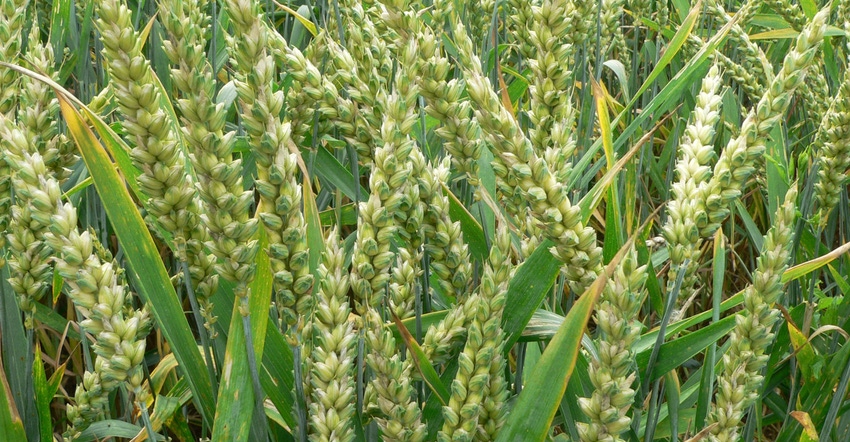
It’s been a chilly, wet spring thus far, and that’s kept the threat of fusarium head blight in barley and wheat at bay. But the weather can change any day, so it’s important to keep an eye on when your small grain will flower and if the weather conditions favor head scab development.
One tool that is helpful is the Fusarium Risk Tool developed by Penn State Extension. It tracks weather conditions around the country and is a good way of keeping an eye on current conditions and risk levels in your area.
Right now, the risk varies depending on susceptible, moderately susceptible and moderately resistant wheat and barley varieties. Susceptible varieties are listed in the “high risk” category, while the risk is low for moderately susceptible and moderately resistant varieties.
Winter wheat is heading across much of Delaware and Maryland. The most recent NASS Crop Progress shows winter wheat heading at 22% in Maryland and 40% in Delaware.
Alyssa Collins, plant pathologist with Penn State Extension, gives her take about the current head scab risk and what growers should be doing to prepare:
Given the current weather conditions and the short-term forecast, what is the risk right now for fusarium head blight? The development of FHB depends on how two factors come together in a season: flowering (anthesis) of wheat or barley, and production of spores of the pathogen that causes the disease, Fusarium graminearum. Both of these are driven in different ways by the weather.
Fungi, in general, benefit from moist or humid conditions to promote their reproduction and help them spread around fields. This fungus, in particular, needs at least 85% humidity and also likes temperatures between 68 and 75 degrees F. That is when it will produce a lot of spores. If the weather conditions that promote spore production line up with the time your crop is flowering, that crop will be at high risk for FHB development.
Rain will also help splash spores into the vulnerable wheat or barley heads.
Our weather to this point has been a bit too chilly in the Northeast to allow for much spore release, so our risk levels are relatively low for this time of year. But this could rapidly change at any time.
The important thing is to keep a close eye on your crop development and try to anticipate flowering. If you are seeing mild, wet conditions forecasted in the days after first heading, be prepared.
We can keep an eye on conditions by visiting the Fusarium Risk Tool in the days following heading in our crops.
At what growth stage per crop is the risk highest for fusarium head blight development? Like I mentioned, flowering is when the pathogen will most easily gain access to the crop and cause the initial infection. But the weeks following flowering can also be important since this is when the fungus can grow and spread within the head from spikelet to spikelet.
If wet, warm weather persists, damage and toxin levels can be worse than if things dried up and stayed dry.
What are the best options for fungicides in dealing with fusarium head blight, and is there anything new this year that growers should know of? There are a handful of very good chemistries we can apply at early flowering to help prevent some infection and toxin production.
The demethylation inhibitor (DMI) products like Caramba and Prosaro remain quite effective. The new player in the game is Miravis Ace. This introduces an additional mode of action and in the past few field seasons we’ve seen disease control just as good as the classic DMI fungicides.
The Miravis Ace label allows for a wider window of application, which will provide some much-needed flexibility in spray timing, but it is a bit more expensive. For more detail on fungicide management for FHB, the Crop Protection Network provides a useful factsheet.
What is the level of DON (vomitoxin) that growers should be aware of and how is it tested? Each buyer will have their own thresholds for DON rejection or dockage, and this is often informed by regional FHB conditions as well as the quantities of clean grain they may have access to.
For folks using the grain as feed for their own animals, they’ll want to test if they noticed a lot of FHB in the crop. Current FDA advisory levels are 10 ppm for ruminating beef and feedlot cattle older than 4 months (cannot exceed 50% of diet); 10 ppm for poultry (cannot exceed 50% of diet); 5 ppm for swine (cannot exceed 20% of diet); and 5 ppm for all other animals (cannot exceed 40% of diet).
The level is 1 ppm for immature and lactating animals.
There are a few testing methods that forage analysis labs, elevators and mills have access to and they all work well. However, there is a great deal of variability in results based on sampling error.
Most sampling at an elevator is conducted using a few probe samples per truckload. This would be fine if the fungus and resulting toxin were evenly distributed among the grain. The reality is that “hotspots” will develop in any given load or bin, and so there can be a few small areas of high concentrations.
If the probe hits one of these hotspots, the result may come back as artificially high in a load that would be, on average, below thresholds. This is why we hear stories of truckloads failing at an elevator and going directly to the back of the line only to test clean the second time through.
It’s just very difficult to efficiently do the kind of thorough sampling that would be needed when grain delivery is at its peak.
Read more about:
FusariumAbout the Author(s)
You May Also Like






